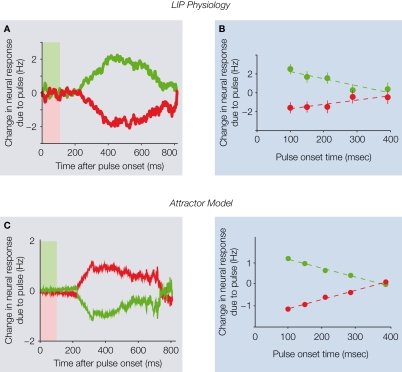Figure 3.
Brief motion pulses exert persistent effects on neural activity. (A) A brief 100 ms motion pulse during motion discrimination of random dot stimulus exerts a long-lasting change in LIP neuronal firing rates. Green (red) trace: positive (negative) pulse in the same (opposite) direction as the random dot motion coherence. Data grouped over all pulse onset times and motion coherences. (B) Violation of time-shift invariance (TSI): instantaneous change in LIP activity due to pulse is not a constant, but decreases with later motion pulse onset time relative to the random dot motion stimulus onset. Green and red: same as (A). (C) Attractor model reproduces experimental data (A,B). (A,B) adapted from Huk and Shadlen (2005), with permission; (C) from Wong et al. (2007).

